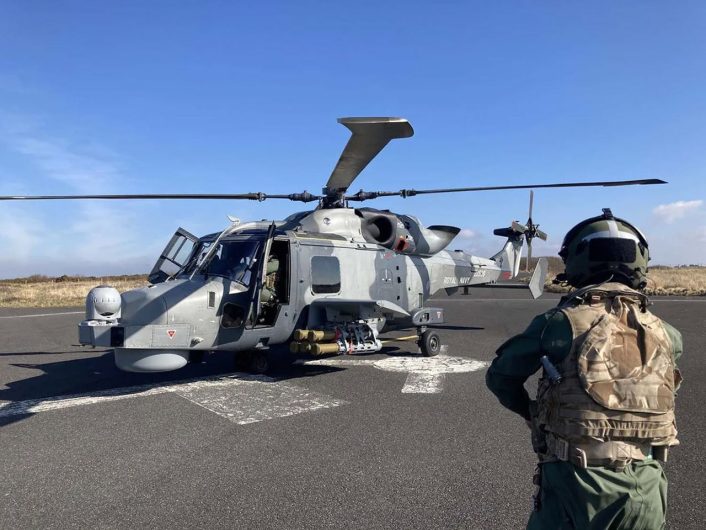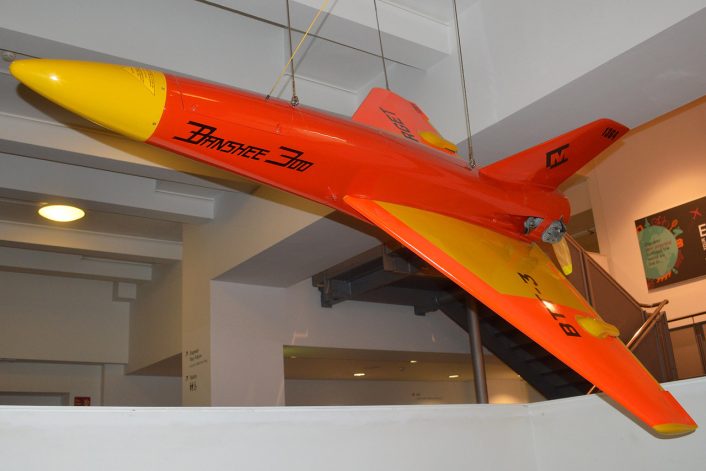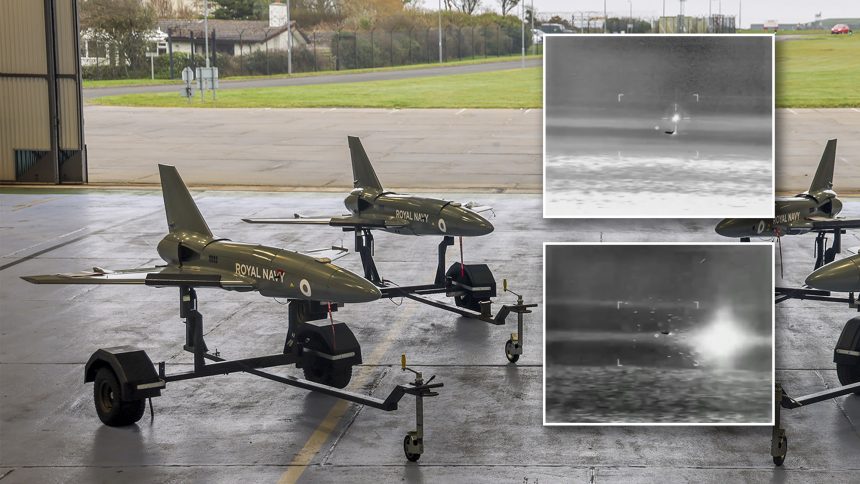The Qinetiq Banshee Jet 80+ target drone has bowed out of Royal Navy service shortly after a live fire exercise where several were shot down by a Wildcat helicopter.
The Banshee 80+ was officially introduced to Royal Navy’s specialist drone unit 700X Naval Air Squadron (NAS) in 2023 to trial the operation of jet powered drones. 700X NAS’ prior experience had largely been with multi-rotor vertical take-off and landing (VTOL) drones, similar to and including commercial quadcopters, as well as fixed wing propeller powered types like the RQ-20 Puma and MQ-27 ScanEagle.
Launched from a portable catapult launcher, either from land or on-board a ship, the twin-engine Banshee Jet 80+ can reach up to 400 mph and offer an endurance in excess of 40 minutes. A deployable parachute allows for the controlled recovery and reuse of the aircraft.
The Royal Navy announced on Apr. 9, 2025, that 700X NAS’ two year trial with the aircraft had drawn to a close, and therefore the aircraft was retired from service. Several days earlier, footage was released from an exercise, referred to as ‘Talon Strike,’ showing a Royal Navy Wildcat HMA2 helicopter using Martlet missiles to shoot down a number of Banshee drones off the coast of Predannack, Cornwall.
This capability had already been proven in prior tests, but the opportunity for further trials was taken in advance of the Carrier Strike Group 25 (CSG 25) deployment, where Martlet equipped Wildcats will be one of several protective assets available for the task force.
700X NAS itself will also be a part of the CSG 25 deployment, providing intelligence, surveillance, and reconnaissance capabilities with the RQ-20 Puma, and notably offering logistics support with Malloy T-150 eVTOL UAVs.

“This event marks the culmination of two years of hard work for team Banshee.” remarked Lieutenant Tony Nairn, Banshee flight commander at 700X NAS. “The engagement with the Wildcat further evidences the Banshee as a valued commodity among the war-fighting community. This is a sign of the ever-developing modern threat.”
.@QinetiQ achieves UK’s first jet-to-autonomous jet teaming between aircraft and modified Banshee Jet 80 drone.
Airborne Command and Control for Swarm Interoperable Missions (ACCSIOM) technology allows UAVs to communicate with crewed aircraft using same messaging format as NATO… pic.twitter.com/amDXuJgygR
— Navy Lookout (@NavyLookout) April 25, 2024
Though the Banshee has left 700X NAS service, the type will continue as a target drone in service elsewhere in the British military, and over its many iterations it has additionally been procured by several overseas customers. Qinetiq continues to develop the Banshee platform, as well as new types with increased capabilities.
This week, we are pleased to join @QinetiQ in the delivery of Exercise Sharpshooter, a live and synthetic training exercise for the Royal Navy.
Taking place at MOD Aberporth, we have designed and delivered a range of threat scenarios for the team onboard HMS Dauntless to face. pic.twitter.com/CLP7RHn0RE
— Inzpire (@InzpireLimited) April 2, 2025
40 Year Veteran
Though the Banshee Jet 80+, as the latest model, is equipped with many modern features, the basic design of the Banshee first took to the skies in 1983. Developed initially by Target Technology Limited, the company later merged into Meggitt Target Systems, who in turn were acquired by Qinetiq in 2016.
The Banshee was originally a propeller powered aircraft, with a single pusher propeller at the rear allowing speeds up to 185 knots. These earlier variants were introduced into dozens of armed forces across the world, becoming one of the most prolific target drones ever produced. Expended drones have been found washed up on a number of beaches, and some units have been handed over to museums for permanent display.

The culmination of propeller-powered Banshee development is the Banshee Whirlwind, which Qinetiq advertises as offering 90 minutes of endurance up to a height of 20,000 feet, as well as speeds of up to 200 knots using a 40 bhp rotary engine.
Jet powered Banshees arrived on the market in 2010 with the Banshee Jet 40, essentially replacing the Whirlwind’s rotary engine with a single jet engine with 40 kilograms of static thrust. Later, an improved Jet 40+ variant was developed. The jet engine increases the Banshee’s maximum speed and altitude to 265 knots and 26,000 feet at the cost of endurance, which is reduced to 65 minutes. The addition of a second jet engine increases the aircraft’s static thrust to approximately 80 kilograms, birthing the Banshee Jet 80 and Jet 80+.
.@hms_kent conducted gunnery practice against Banshee drone targets during #BALTOPS2020 exercise pic.twitter.com/ibpREQyD54
— Navy Lookout (@NavyLookout) June 18, 2020
All currently offered Banshee variants (Whirlwind, Jet 40+, Jet 80+) are able to be configured with a mix of visible smoke and infrared tracking flares, Luneberg lenses, infrared and radar countermeasure dispensers, and range instrumentation. The nose section of the aircraft can be removed and replaced with Qinetiq’s ‘Hot Nose’ missile simulation system, which replicates the infrared signature generated by aerodynamic heating at high supersonic speeds.
Radar altimeters allow Banshee targets to operate down to a minimum altitude of 5 meters, providing the capability to simulate sea-skimming anti-ship missiles. All models are able to carry an IFF transponder with Mode A and Mode C capabilities. The Jet 80+, at least, has also demonstrated the ability to transmit ADS-B, as they have been tracked using the technology on websites such as Flightradar24 and ADS-B Exchange.
MOD QinetiQ Banshee target-drone operating off Cornwall today. pic.twitter.com/6tz3Y7DjgV
— JamesFennell.bsky.social (@FennellJW) March 16, 2025
Banshees have an integrated GPS with autonomous waypoint navigation through Qinetiq’s Combined Autopilot and Surveillance Payload Avionics (CASPA) system.
Qinetiq says Banshee target drones have been used to test the operational effectiveness of a huge range of air defense systems. This includes air-to-air missiles such as the AIM-7 Sparrow, AIM-9 Sidewinder, AIM-120 AMRAAM, Meteor, MICA, Aspide, and R550 Magic.
IRIS-T is listed as having been tested against the Banshee in a surface-to-air capacity, alongside the MIM-104 Patriot, FGM-148 Javelin, FIM-92 Stinger, Crotale, Starstreak, and RIM-162 ESSM. Gun systems that have engaged Banshee drones include Phalanx, Goalkeeper, Sea Zenith, and a range of medium-large caliber naval cannons.
Ukraine
The United Kingdom has provided an unspecified number of Banshee drones to Ukraine as part of its military aid packages. This reportedly includes the latest Jet 80+ type. In Ukrainian service the configurable forward section of the aircraft is frequently adapted with a small explosive warhead, turning the target drone into an effective ‘suicide’ attack drone.
British-made Banshee target drone reported crashed behind 🇷🇺Russian lines.
Banshee Jet 80 is a twin jet drone used a training target by the RN (Project VAMPIRE) and others. In🇺🇦Ukrainian service it is likely being used as a one-way attack drone (OWA-UAV).
Via @CovertShores… pic.twitter.com/0FlNtyl9le
— Navy Lookout (@NavyLookout) February 20, 2024
It is not known whether 700X NAS’ remaining units, if any, may comprise future aid shipments to Ukraine for further use in this role. Adding to the 10,000 drones the UK says it has already supplied to Ukraine, on Mar. 6, 2025 Secretary of State for Defence John Healey announced a deal with Anduril that will see the company’s Altius-600m and 700m multirole drones/loitering munitions supplied to Ukraine in contracts worth £30 million.









